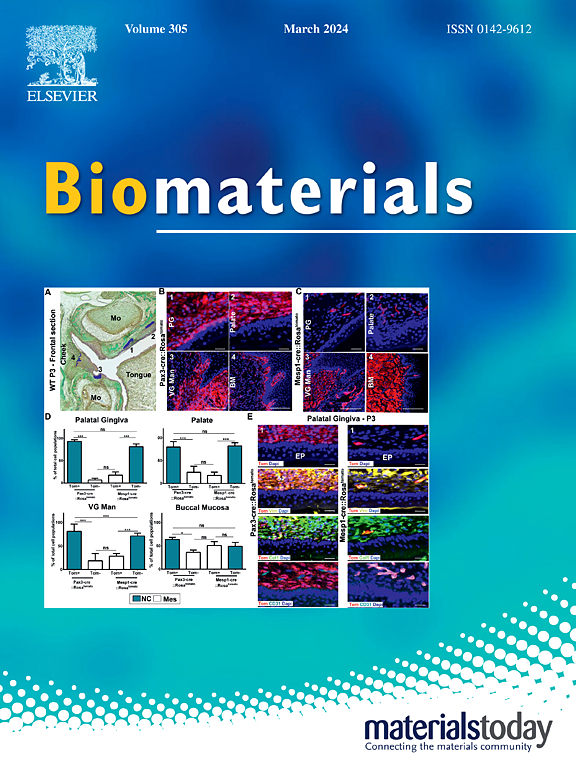Electrode stimulation parameter modifications elicit differential glial cell responses in vitro over a short 4-h timecourse
IF 12.8
1区 医学
Q1 ENGINEERING, BIOMEDICAL
引用次数: 0
Abstract
A cell culture model to assess glial cell responses to electrically stimulating electrodes in real-time was developed. Our previous work measured glial cell responses to stimulation paradigms and highlighted the importance of electrical stimulation considerations when designing a biocompatible neural interfacing device. The formation of voids around stimulating platinum-iridium electrodes also prompted an investigation into the fate of cells that would have once populated that area. Live-imaging experiments involving EGFP-positive microglia from heterozygous CX3CR-1+/EGFP mice were designed. Live-imaging animations over 4 h showed necrotic microglial cell death around stimulating electrodes. The degree to which this was occurring was further analyzed by electrically stimulating mixed glia and modifying parameters such as stimulation amplitude (0.1–0.4 mA), waveform shape (rectangular/sinusoidal/ramped), and frequency (25–55 Hz). The different stimulation parameters had differential effects on glial cell biomarker signal outputs (cell density, fluorescence intensity, area coverage). Scanning electron microscopy and energy-dispersive x-ray spectroscopy of the electrode surfaces post-stimulation did not reveal any significant damage or changes to surface elemental composition. Finally, electrochemical testing of the proposed in vitro setup revealed influences of different components of the mixed glial cell cultures towards the electrochemical performance of the electrodes in terms of cathodic charge storage capacity, impedance, phase angle, and voltage transient excursions. The results highlight the impact that electrical stimulation parameters have on glial cell fate at the electrode-cell culture interface, and provide data towards refinement of stimulation paradigms used in electrical neuromodulation applications.
电极刺激参数的改变在体外短4小时的时间内引起胶质细胞的差异反应
开发了一种细胞培养模型,用于实时评估神经胶质细胞对电刺激电极的反应。我们之前的工作测量了神经胶质细胞对刺激模式的反应,并强调了在设计生物相容性神经接口装置时考虑电刺激的重要性。在刺激铂铱电极周围形成的空洞也促使人们对曾经在该区域居住的细胞的命运进行了调查。设计了杂合子CX3CR-1+/EGFP小鼠EGFP阳性小胶质细胞的实时成像实验。超过4小时的实时成像动画显示刺激电极周围坏死的小胶质细胞死亡。通过电刺激混合胶质细胞并修改刺激幅度(0.1-0.4 mA)、波形形状(矩形/正弦/斜面)和频率(25-55 Hz)等参数,进一步分析这种情况的发生程度。不同的刺激参数对胶质细胞生物标志物信号输出(细胞密度、荧光强度、面积覆盖)有不同的影响。刺激后电极表面的扫描电子显微镜和能量色散x射线光谱学没有发现任何明显的损伤或表面元素组成的变化。最后,对所提出的体外装置进行电化学测试,揭示了混合胶质细胞培养物的不同成分对电极阴极电荷存储容量、阻抗、相角和电压瞬态偏移等电化学性能的影响。结果强调了电刺激参数对电极-细胞培养界面上神经胶质细胞命运的影响,并为电神经调节应用中使用的刺激范式的改进提供了数据。
本文章由计算机程序翻译,如有差异,请以英文原文为准。
求助全文
约1分钟内获得全文
求助全文
来源期刊

Biomaterials
工程技术-材料科学:生物材料
CiteScore
26.00
自引率
2.90%
发文量
565
审稿时长
46 days
期刊介绍:
Biomaterials is an international journal covering the science and clinical application of biomaterials. A biomaterial is now defined as a substance that has been engineered to take a form which, alone or as part of a complex system, is used to direct, by control of interactions with components of living systems, the course of any therapeutic or diagnostic procedure. It is the aim of the journal to provide a peer-reviewed forum for the publication of original papers and authoritative review and opinion papers dealing with the most important issues facing the use of biomaterials in clinical practice. The scope of the journal covers the wide range of physical, biological and chemical sciences that underpin the design of biomaterials and the clinical disciplines in which they are used. These sciences include polymer synthesis and characterization, drug and gene vector design, the biology of the host response, immunology and toxicology and self assembly at the nanoscale. Clinical applications include the therapies of medical technology and regenerative medicine in all clinical disciplines, and diagnostic systems that reply on innovative contrast and sensing agents. The journal is relevant to areas such as cancer diagnosis and therapy, implantable devices, drug delivery systems, gene vectors, bionanotechnology and tissue engineering.
 求助内容:
求助内容: 应助结果提醒方式:
应助结果提醒方式:


